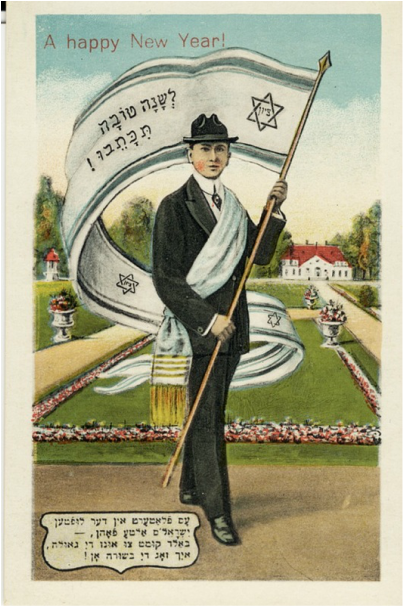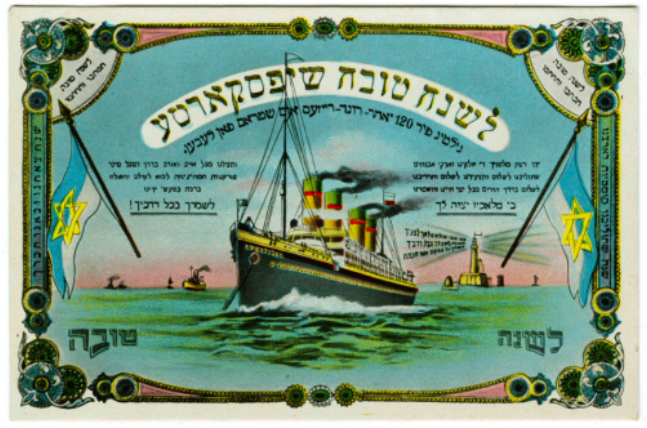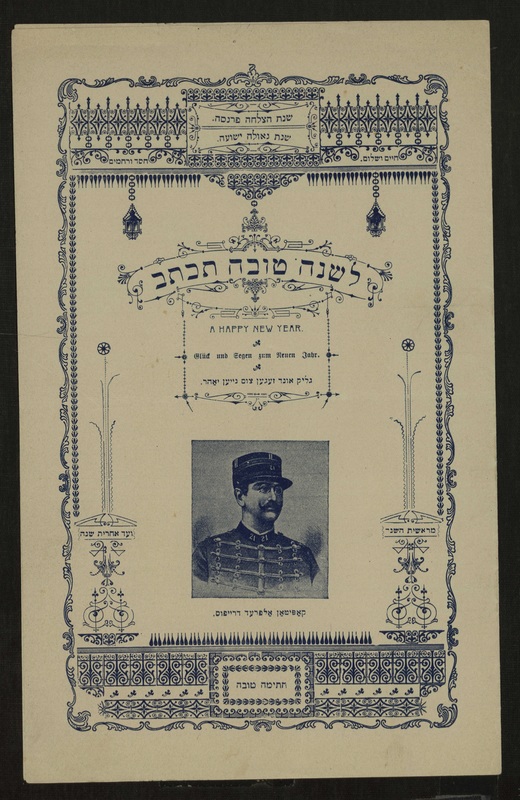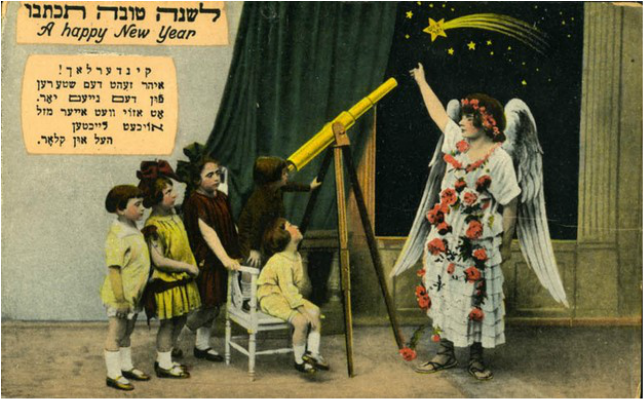 My sister Mindy’s rendition of our great aunt’s pflaumenkuchen, baked in honor of the autumn Jewish High Holidays. (Courtesy of Mindy Schiller, September 2015.) My sister Mindy’s rendition of our great aunt’s pflaumenkuchen, baked in honor of the autumn Jewish High Holidays. (Courtesy of Mindy Schiller, September 2015.) As far back as I can remember, one of the hallmarks of the upcoming autumn Jewish High Holidays for me were Rosh Hashanah, or Jewish New Year greeting cards. Of course, this accompanied the other signs of the season – namely, the honey cake (often called lekakh in Yiddish) my mother made à la the late Fanny Opper; my grandmother Tola’s apple cake (that was not limited only to this time of the year); my great aunt Lola’s pflaumenkuchen (or plum cake, which we always called flomenkikhen in Yiddish) – acquired during the period when she lived in Germany following World War II – and the decorations that my younger siblings and I would make for our family’s sukkah – or suke, in Yiddish [i.e., a booth or hut-like structure used during the holiday of Sukkot. Rosh Hashanah greeting cards, though, served multiple functions in my home. Not only did we send and receive these lovely reminders of the upcoming Jewish New Year holiday (and beyond), but we also used them as decorations from one year to the next in our sukkah. My father would collect all of the greeting cards that we had received in the days and weeks leading up to Sukkot – Sukes in Yiddish – or frequently called the “Feast of Tabernacles” in English – and take them to a nearby teacher’s center where he would have the cards laminated in large sheet form. We would then string these sizable swathes of laminated cards alongside the inner walls of our tarp-covered sukkah. This served as a festive and visually stunning reminder of holidays gone by and of all the friends and relatives whose names were attached to these mementos of yesteryear. Although most of the cards I saw over the years growing up in the United States in the 1980s and 1990s were in English and Hebrew, here and there we would also receive cards bearing Yiddish greetings. Mainly, I would see the handwritten messages scrawled upon the greeting cards my grandmother and great aunt received respectively from their cousins Yedis and Diana in Israel, and Rebeka in Brazil. Since they had all come from Warsaw, but subsequently lived in different countries and were not all equally well-versed in Polish, English, Hebrew, or in Portuguese, for that matter, Yiddish was their main written lingua franca. I always marveled at how these women had steadily managed to retain their ties to one another, even though they had not seen each other for so many years, and were divided both by time and space. Furthermore, I was impressed that Yiddish served as their common conduit of communication – even though they probably used it little in its written form in the years following their respective transmigrations from Europe, both before and after World War II. Those cards, in particular, were a sort of keyhole for me into another world – or, at least, into the remnants of that other world – and I could appreciate just how precious they were.  The Yiddish message printed on the upper right-hand side of this serene-looking Jewish New Year card reads: “Wake up, take a New Year now! God unlocks treasures, might and joy, and He will add days of happiness, and He makes your life bright!” (Courtesy of www.defendinghistory.com, accessed 9-25-16.) These are some of my personal associations with Rosh Hashanah greeting cards and the autumn Jewish High Holiday season (that is now upon us) going back to my childhood. But more recently, I began to wonder about the actual history surrounding these cards – when did they originate and where, and how have they changed and developed over time? Now that I have read up somewhat on the subject, please allow me to share a few of my findings with you in my most current blog. Also, given that my blogs pertain to my forays into Yiddish, I have included a montage of Rosh Hashanah greeting cards here that highlights the use of Yiddish – in addition to some of the other languages more widely used for this purpose today – namely, English and Hebrew.  This 3-dimensional Rosh Hashanah greeting card is clearly quite Zionist in its orientation, given that the Yiddish on the front and verso sides of this artwork (across the top, in gold print) reads: “Panorama of Tel-Aviv” and the front side includes a woman waving an Israeli flag of sorts, while surrounded by the beautiful scenery of Israel. (Hebrew Publishing Company, c. 1906-1912, New York, United States (Germany?); courtesy of Yeshiva University Museum: www.yumuseum.org, accessed 9-25-16.) Remarkably, the custom of sending Jewish New Year greeting cards dates back considerably – all the way to the Middle Ages – thereby significantly predating the Christian New Year card tradition, which only became popular in Europe and the United States during the 19th century. Among the earliest references to this Jewish custom is that of a recommendation made by Rabbi Jacob Moellin (c. 1365-1427; also known as the “Maharil”), spiritual leader of German Jewry in the 14th century in his work, Minhagei Maharil (First edition compiled by one of the “Maharil’s” students; Sabionetta, 1556). It is there that Rabbi Moellin is quoted as saying that during the Jewish month of Elul – the month that paves the way to the autumn High Holidays – letters should contain the Hebrew blessing: "כתיבה וחתימה טובה" which means: “May you be inscribed and sealed for a good year.” This message has subsequently become one of the most standard expressions used during the days leading up to Rosh Hashanah, and it is included in many holiday greeting cards even up until the present.  The Yiddish caption on the bottom of this pro-Zionist Jewish New Year greeting card reads: “Israel’s old flag is fluttering in the wind – soon, the redemption will come to us; I am announcing the news!” (Courtesy of www.blogspot.com, accessed 9-25-16.) The Yiddish caption on the bottom of this pro-Zionist Jewish New Year greeting card reads: “Israel’s old flag is fluttering in the wind – soon, the redemption will come to us; I am announcing the news!” (Courtesy of www.blogspot.com, accessed 9-25-16.) Thus, this custom originated among Ashkenazi Jews of the German Lands, and then gained momentum elsewhere, as well – ultimately reaching Sephardic and Oriental (or “Mizrachi,” in Hebrew) Jews in more recent generations. What helped to further popularize this practice was the invention of the “correspondence card” (or a postcard without a picture) in Vienna in 1869 and the illustrated postcard that took off during the so-called “Great Post Card Craze” (a title coined by Puck magazine in 1906), which spanned roughly from 1898 to 1920. During this “Craze,” the Jewish New Year greeting card also became more widespread in three major regions: Germany, Poland, and the United States. The German-produced cards frequently bore biblical themes, while those printed in Warsaw, for example, tended to exhibit nostalgic Eastern European Jewish religious scenes. The latter greeting cards even made use of amateur actors who modeled for multiple such illustrations. I suspect that this may have been the case in the following Jewish New Year greeting card, which features a man and a woman who appear familiar to me from other, similarly designed Rosh Hashanah greeting cards that were likely printed in the same unaccounted for time period and place as this one.  The Yiddish caption on the lower left-hand side of this Jewish New Year greeting card reads: “Her sweet voice rings [out] from the radio: `I wish you, darling, might and glory. May you achieve what you want and find happiness everywhere!’” The building in the center column, whose identity remains indeterminate to me, also bears the simple Yiddish words: “Jewish Academic Home.” (Author’s private collection, care of the YIVO Institute for Jewish Research.) During the early 20th century, Jewish New Year greeting cards issued in Eastern Europe also featured themes of immigration with either America or Palestine – otherwise referred to at that time as “Eretz Yisrael” (Hebrew for “The Land of Israel”) – playing prominent roles. Hence, it is not uncommon to find images of trains, steamships, the Statue of Liberty, Israeli flags, or Stars of David surrounding the Hebrew word for “Zion” depicted in the Rosh Hashanah greeting cards of that era. Some of the many such examples include the following two similar-looking cards, which include all of the various images I mentioned above.  The Yiddish in bold print across the top of this “Coming to America”-themed Rosh Hashanah greeting card reads: “A New Year’s Ship’s [Passenger] Card”; and just below that, in smaller print, the Yiddish reads: “Valid for 120 years of round-trips on the stream of life.” (Printed in Germany for the Hebrew Publishing Company, New York, c. 1900; courtesy of www.ingeveb.org, accessed 9-30-16.)  As in the previous card, the Yiddish in bold print across the top of this immigration-oriented Rosh Hashanah greeting card reads: “A New Year’s Ship’s [Passenger] Card”; and just below that, in smaller print, the Yiddish reads: “Valid for 120 years of round-trips on the stream of life.” (Courtesy of www.tumblr.com, accessed 9-25-16.) The Jewish New Year greeting cards printed during the 1920s and 1930s continued to showcase additional Zionist-oriented themes – namely, the acquisition of the land and the “Chalutz” (Hebrew for “pioneer”) dream of working the land. Since many of the new “Chalutzim” were ideologically quite secular, the cards of this era do not generally depict “Zion” in a religious or spiritual light. Rather, in the guise of a socio-political Jewish homeland. These new cards were a reflection on the increasing immigration of Jews to Palestine from the mid-1920s to the mid-1930s, primarily from Eastern and Central Europe. The leading causes of this particular wave of Jewish immigration were the persecution of Jews in Nazi Germany, as well as the anti-Jewish economic legislation in Poland, coupled with the United States’ highly restrictive immigration quotas. Since the establishment of the State of Israel in 1948, numerous types of Rosh Hashanah greeting cards have been printed there, predominantly in Hebrew. The custom of sending cards continued to flourish in Israel – just as it did in the United States – until the advent and use of the internet became increasingly widespread in the 1990s. Nowadays (c. 2016), the trend appears to be aimed progressively toward phone calls and internet messages, with the occasional handwritten cards to certain friends and relatives. Sadly, the art of the handwritten Jewish New Year greeting card has gone the way of card and letter-writing in general. It has become a bit of a lost and cherished art, which I would greatly like to see revived, and perhaps even resurrected.  In this unusual Jewish New Year greeting card, which depicts the tragic historic figure of Captain Alfred Dreyfus of the French Army, we see the use of four languages: Hebrew, English, German, and Yiddish. Perhaps ironically, French does not appear at all in this text. Both the German and Yiddish that appear above the image of Dreyfus read: “Fortune and blessing for the New Year.” The caption below Dreyfus’ image reads simply (in Yiddish): “Captain Alfred Dreyfus.” Since the “Dreyfus Affair” spanned the years 1894-1906, it is probable that this card appeared during that same period. (Courtesy of the National Library of Israel: http://web.nli.org.il, accessed 9-30-16.)  This personalized Rosh Hashanah greeting card depicts Jewish refugees/Holocaust survivors, presumably taken in or near one of the Displaced Persons camps in 1947. The Yiddish inscription at the bottom reads: “The most heartfelt wishes for the new year.” (Courtesy of Yad Vashem: www.yadvashem.org, accessed 9-25-16.) Seeing as this is a time both for reflection, as well as for new beginnings, I would like to conclude by thanking all of you who regularly read my blog posts. And for those of you who are new to my blog, I invite you to please sign up to receive my future postings – if you have not already done so – and to share these articles with your friends and relatives. This may be done on the Home page of my website: www.rivkasyiddish.com. I also welcome comments about other Yiddish language Rosh Hashanah cards, as I was only able to include a limited number of these examples in my blog.
Please feel free to contact me at: [email protected], should you have any Yiddish language Jewish New Year greeting cards, or any other materials that you would like translated.
19 Comments
Jeanne Gagnaux
10/9/2016 07:03:20 am
A groysen dank Rivka far di sheyne bilder !
Reply
10/9/2016 07:20:14 am
Nishto far vos (You're welcome), Jeanne! I'm glad you enjoyed the pictures. I only wish I had the space here to include more. I found so many beautiful images -- both online and within my own personal collection -- but I had to draw the line somewhere.
Reply
Eric
10/9/2016 08:03:28 am
The Jewish Academic Home pictured in one of your postcards - in Warsaw: http://www.sztetl.org.pl/en/article/warszawa/39,heritage-sites/3521,jewish-dormitory-at-7-sierakowskiego-street/
Reply
Rivka Schiller
10/9/2016 09:01:16 am
Thank you very much, Eric, for enlightening me about the source of the "Yudishe akademishe heym" = "Jewish Academic Home" featured in one of these postcards.
Reply
Rivkah Blau
10/9/2016 09:27:34 am
Rivka, your memories of a beautiful family life are a meaningful way to start the week that has Yom Kippur at its center.
Reply
10/9/2016 10:43:38 am
Rivkah,
Reply
Fredda Nightingale
10/9/2016 10:41:27 am
Hi Rivka,
Reply
10/9/2016 10:46:13 am
Hi Fredda,
Reply
Milton
10/9/2016 01:00:48 pm
Hi Rivka -
Reply
10/9/2016 01:10:52 pm
Hi Milton,
Reply
Peter
10/9/2016 03:42:53 pm
Great job of presenting the various Yiddish Rosh Hashonna cards.
Reply
10/9/2016 05:08:44 pm
Dear Peter,
Reply
Lily Zajc
10/10/2016 08:06:13 am
Very interesting postcards - a history lesson!
Reply
10/10/2016 08:14:47 am
Thank you, Lily, for your nice comment. Yes, that was a bit of my aim here -- to present some Jewish history through the beautiful visuals of Rosh Hashanah greeting cards -- in Yiddish, no less!
Reply
Brenda Ajzenkopf
10/13/2016 12:12:43 pm
Hello Rivka
Reply
Rivka Schiller
10/13/2016 12:45:21 pm
Hello Brenda,
Reply
10/27/2016 07:23:31 pm
What an utterly lovely and simple idea to decorate a sukkah with greeting cards. Alas, they seem to be a thing of the past. I hardly send them out myself anymore and we receive only a smattering now.
Reply
10/28/2016 12:55:19 pm
Thank you very much, Annette, for your nice remarks. Yes, I was hoping to provide some additional Sukkah decoration ideas here, as well. But I completely sympathize with you, as actual hard copy Jewish New Year greeting cards are so few and far between these days.
Reply
Hugh Gerechter
9/17/2020 12:41:41 pm
Enjoyed reading your post -- the Polin Museum link you gave for the Jewish Academic Home did not work for me. Here's one that did:
Reply
Your comment will be posted after it is approved.
Leave a Reply. |



 RSS Feed
RSS Feed